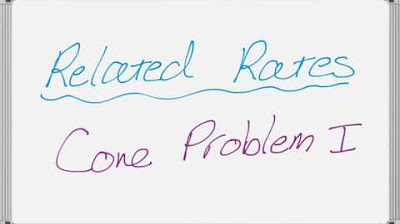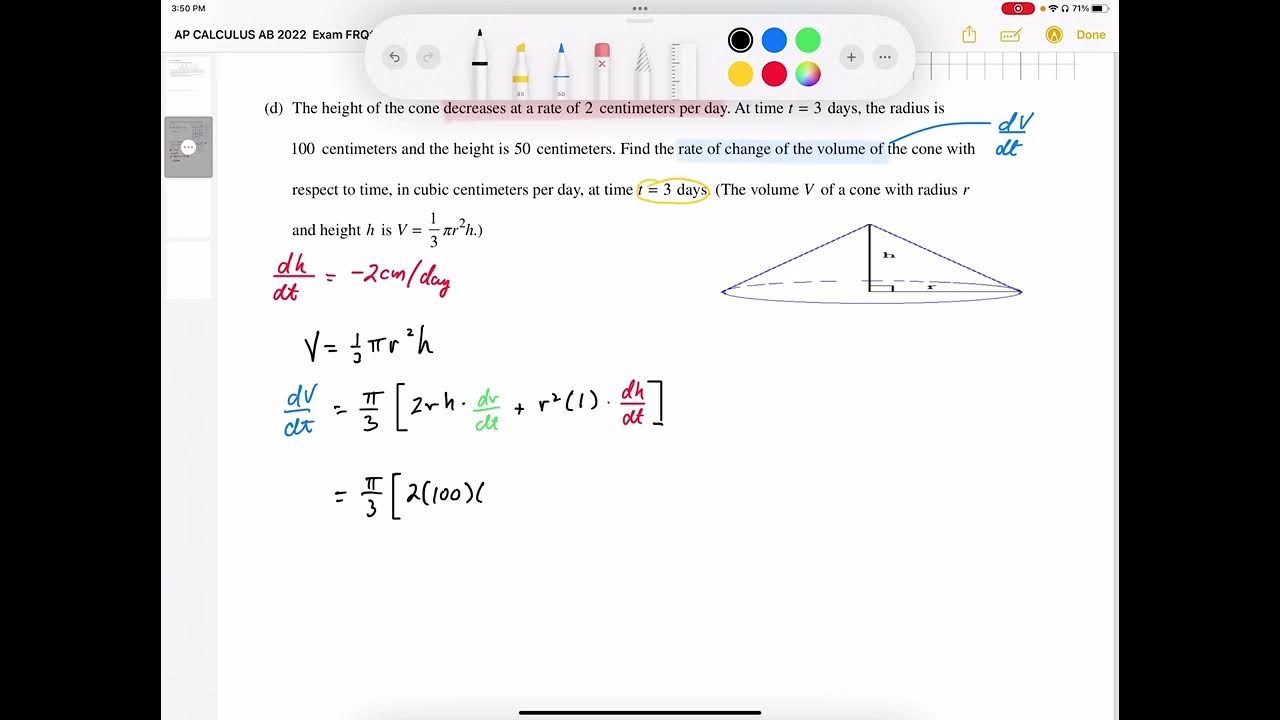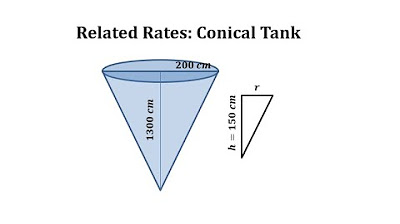Related Rate Problem #3 - Volume of a Conical Tank
TLDRIn this educational video, the instructor tackles a related rate problem involving a right circular cone used as a fuel tank, with given dimensions of height 50 and radius 30. The video begins by illustrating the cone as an isosceles triangle and a circle. The primary challenge is to find out how fast the fuel level rises when the tank has been filled with 861 cubic feet of fuel, given a filling rate of 112 cubic feet per second. Using the concept of similar triangles, the instructor simplifies the volume formula, and through implicit differentiation, calculates the rate of change of the fuel level's height, concluding with a change rate of 0.57 units per second.
Takeaways
- 📐 The problem involves a right circular cone, representing a fuel tank, with a height of 50 and a radius of 30.
- ⛽ The tank can be filled at a rate of 112 cubic feet per second, which is a measure of volume with respect to time.
- 🔍 The goal is to find the rate at which the level of the gas in the tank is rising after 861 cubic feet has been pumped in.
- 🧮 The volume of a cone is given by the formula V = \( \frac{1}{3} \pi r^2 h \), where \( r \) is the radius and \( h \) is the height.
- 🔑 Using similar triangles, the relationship \( r = \frac{3}{5}h \) is derived to eliminate the radius from the volume formula.
- 📉 By substituting \( r \) in terms of \( h \), the volume formula is simplified to V = \( \frac{9\pi}{75} h^3 \).
- 🔢 Given the volume V = 861, the corresponding height \( h \) is solved to be approximately 13.17.
- 📌 Implicit differentiation of the volume formula with respect to time yields \( \frac{dv}{dt} = \frac{27\pi}{75} h^2 \frac{dh}{dt} \).
- ⏱️ To find the rate of change of height with respect to time (\( \frac{dh}{dt} \)), the equation is rearranged and values are substituted in.
- 📏 The final calculation gives a rate of change of height (\( \frac{dh}{dt} \)) as 0.57 units per second.
- 🎯 The answer to the related rate problem is that the height of the gas in the tank rises at a rate of 0.57 units per second after 861 cubic feet has been pumped in.
Q & A
What is the shape of the fuel tank described in the script?
-The fuel tank is in the shape of a right circular cone.
What are the dimensions of the cone-shaped fuel tank mentioned in the script?
-The height of the cone is 50 units and the radius is 30 units.
What is the rate at which the tank can be filled in terms of volume per second?
-The tank can be filled at a rate of 112 cubic feet per second.
What is the formula used to calculate the volume of a cone?
-The formula to calculate the volume of a cone is V = (1/3) π r^2 h, where r is the radius and h is the height of the cone.
How does the script use similar triangles to eliminate the radius from the volume formula?
-The script uses the concept of similar triangles to establish a relationship between the radius and height of the cone, resulting in r = (3/5)h, which is then used to eliminate r from the volume formula.
What is the modified volume formula after eliminating the radius using similar triangles?
-The modified volume formula is V = (9π/75) h^3.
What is the volume of the tank when 861 cubic feet of fuel has been pumped in?
-When the volume is 861 cubic feet, the height of the gas in the tank is 13.17 units.
How is the derivative of the volume with respect to time represented in the script?
-The derivative of the volume with respect to time is represented as (dv/dt) and is used to find the rate of change of the height with respect to time.
What is the final expression to find the rate of change of the height with respect to time?
-The final expression to find the rate of change of the height with respect to time is (dh/dt) = (112 * 75)/(27π * h^2).
What is the rate at which the level of the gas in the tank is rising after 861 cubic feet has been pumped in?
-The level of the gas in the tank is rising at a rate of 0.57 units per second after 861 cubic feet has been pumped in.
How does the script ensure that the units of measurement are consistent throughout the problem?
-The script consistently uses units of cubic feet for volume and seconds for time to ensure that the units of measurement are consistent throughout the problem.
What is the significance of the rate of change of the height with respect to time in the context of the problem?
-The rate of change of the height with respect to time is significant as it directly answers the question of how fast the level of the gas in the tank is rising, which is the main objective of the related rate problem.
Outlines
📐 Understanding the Related Rate Problem with a Cone Shaped Fuel Tank
This paragraph introduces a related rate problem involving a right circular cone, which represents a fuel tank. The problem provides the height (50 units) and radius (30 units) of the cone, and states that the tank can be filled at a rate of 112 cubic feet per second. The goal is to determine how fast the level of the gas in the tank is rising after 861 cubic feet have been pumped in. To solve this, the presenter uses the concept of similar triangles to eliminate the radius from the volume formula, resulting in a new formula where volume is a function of height only. The volume formula is then rearranged to solve for height when the volume is 861 cubic feet, which is a crucial step in finding the rate of change of height with respect to time.
🔢 Calculating the Rate of Change of Height in the Cone Tank
In this paragraph, the presenter calculates the rate at which the height of the gas in the tank is rising. They start by finding the height of the tank when it contains 861 cubic feet of gas, which turns out to be 13.17 units. The presenter then takes the derivative of the volume formula with respect to time, resulting in an equation that relates the rate of change of volume (dv/dt) to the rate of change of height (dh/dt). By substituting the known values, including the rate of volume change (112 cubic feet per second) and the calculated height (13.17 units), they solve for the rate of change of height (dh/dt). The final calculation yields a rate of 0.57 units per second, which is the rate at which the gas level is rising in the tank.
Mindmap
Keywords
💡Related Rate Problem
💡Right Circular Cone
💡Volume
💡Implicit Differentiation
💡Similar Triangles
💡Derivative
💡Cubic Feet
💡Isoceles Triangle
💡Fuel Tank
💡Rate of Change
💡Pi (π)
Highlights
The video discusses a related rate problem involving a right circular cone-shaped fuel tank.
The height of the cone is given as 50 units and the radius as 30 units.
The tank can be filled at a rate of 112 cubic feet per second.
The problem aims to find the rate at which the gas level in the tank rises after 861 cubic feet have been pumped in.
A formula relating volume, radius, and height of a cone is introduced: V = (1/3)πr^2h.
The radius of the tank is eliminated from the formula using similar triangles, resulting in V = (9π/75)h^3.
To find the height corresponding to a volume of 861 cubic feet, the formula is solved to yield h = 13.17 units.
The derivative of the volume with respect to time is taken to find the rate of change of height (dh/dt).
The derivative results in the equation: dv/dt = (27π/75)h^2(dh/dt).
By substituting the given rate of volume change (112 cubic feet per second), the rate of height change is solved.
The final calculation shows that the height of the gas in the tank is rising at a rate of 0.57 units per second.
The problem-solving approach involves using geometric properties and calculus to solve real-world physics problems.
The video provides a step-by-step method to tackle related rate problems in the context of a cone's volume.
The importance of understanding the relationship between volume, height, and radius in a cone is emphasized.
The video demonstrates the application of calculus in determining rates of change in geometrical figures.
The use of similar triangles is highlighted as a technique to simplify the mathematical model of the problem.
The video concludes with the practical application of the mathematical solution to determine the rate of gas level rise in a tank.
The problem illustrates the integration of mathematical concepts with real-world scenarios in engineering and physics.
Transcripts
Browse More Related Video
5.0 / 5 (0 votes)
Thanks for rating:





